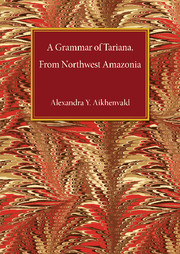Book contents
- Frontmatter
- Dedication
- Contents
- List of tables, schemes and diagrams
- Preface
- Acknowledgements
- Organisation and cross-referencing
- List of abbreviations
- Map
- 1 The language and its speakers
- 2 Phonology
- 3 Word classes
- 4 Nominal morphology and noun structure
- 5 Noun classes and classifiers
- 6 Possession
- 7 Case marking and grammatical relations
- 8 Number
- 9 Further nominal categories
- 10 Derivation and compounding
- 11 Closed word classes
- 12 Verb classes and predicate structure
- 13 Valency changing and argument rearranging mechanisms
- 14 Tense and evidentiality
- 15 Aspect, Aktionsart and degree
- 16 Mood and modality
- 17 Negation
- 18 Serial verb constructions and verb compounding
- 19 Complex predicates
- 20 Participles and nominalisations
- 21 Clause types and other syntactic issues
- 22 Subordinate clauses and clause linking
- 23 Relative clauses
- 24 Complement clauses
- 25 Discourse organisation
- 26 Issues in etymology and semantics
- Appendix. The main features of the Tariana dialects
- Texts
- Vocabulary
- References
- Index of authors, languages and subjects
4 - Nominal morphology and noun structure
Published online by Cambridge University Press: 05 August 2013
- Frontmatter
- Dedication
- Contents
- List of tables, schemes and diagrams
- Preface
- Acknowledgements
- Organisation and cross-referencing
- List of abbreviations
- Map
- 1 The language and its speakers
- 2 Phonology
- 3 Word classes
- 4 Nominal morphology and noun structure
- 5 Noun classes and classifiers
- 6 Possession
- 7 Case marking and grammatical relations
- 8 Number
- 9 Further nominal categories
- 10 Derivation and compounding
- 11 Closed word classes
- 12 Verb classes and predicate structure
- 13 Valency changing and argument rearranging mechanisms
- 14 Tense and evidentiality
- 15 Aspect, Aktionsart and degree
- 16 Mood and modality
- 17 Negation
- 18 Serial verb constructions and verb compounding
- 19 Complex predicates
- 20 Participles and nominalisations
- 21 Clause types and other syntactic issues
- 22 Subordinate clauses and clause linking
- 23 Relative clauses
- 24 Complement clauses
- 25 Discourse organisation
- 26 Issues in etymology and semantics
- Appendix. The main features of the Tariana dialects
- Texts
- Vocabulary
- References
- Index of authors, languages and subjects
Summary
The grammatical properties of nouns as a word class and of distinct subclasses of nouns (prefixed vs. non-prefixed nouns, nouns with a human referent, kinship nouns, personal names, inanimate nouns, inherently locative nouns and placenames) are considered in §3.1.2. Here I present an overview of nominal morphology and of the structure of a nominal word.
Tariana is a polysynthetic language which combines head-marking morphology with elements of dependent marking (see §1.1). Unlike most languages of the world, nouns in Tariana are not only derivationally, but also inflectionally complex. They can take up to sixteen structural positions (one of which is a prefix position). These include classifiers, tense (future and past), extralocality, contrastitivity, cases and various other affixes and enclitics. Some of these categories can be expressed iteratively, that is, more than once. Such categories include noun class markers (see Chapters 5 and 10), and plural (see Chapter 8). The structure of a noun in Tariana is shown in Diagram 4.1.
A minimal nominal word can consist just of a root, or of a prefix plus a root (depending on the type of the root: whether it is alienably or inalienably possessed – see Chapter 6), or of a root plus a gender-sensitive-suffix. A grammatical word in Tariana is generally centred on a root. There are few compounds which consist of two roots, e.g. ñapu-iheni (stream-fish) ‘fish from little streams’, puali-syawa (oven-fire) ‘oven fire’, or sa-kamu (smoke-hot) ‘warm’ (see §10.5).
- Type
- Chapter
- Information
- A Grammar of Tariana, from Northwest Amazonia , pp. 82 - 86Publisher: Cambridge University PressPrint publication year: 2003



